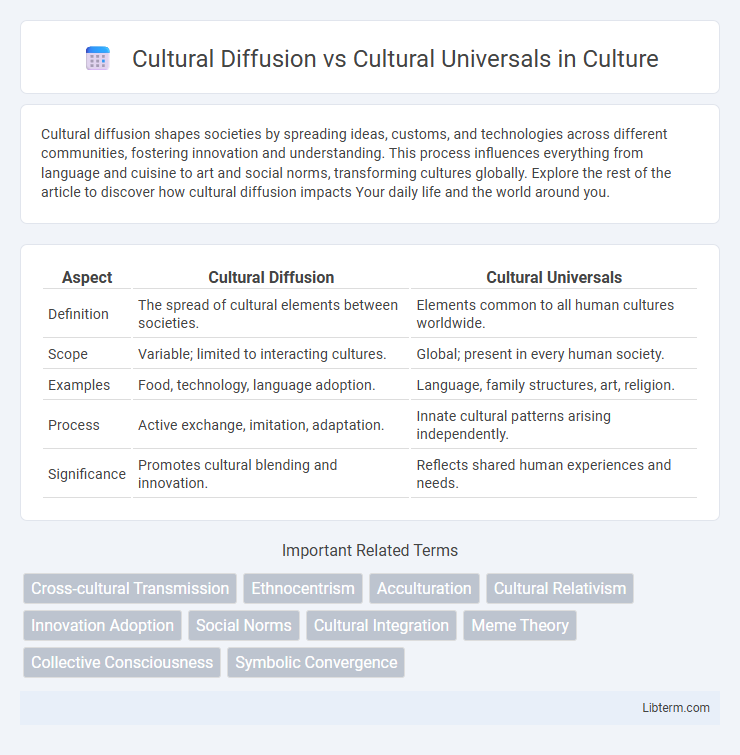Cultural diffusion shapes societies by spreading ideas, customs, and technologies across different communities, fostering innovation and understanding. This process influences everything from language and cuisine to art and social norms, transforming cultures globally. Explore the rest of the article to discover how cultural diffusion impacts Your daily life and the world around you.
Table of Comparison
| Aspect | Cultural Diffusion | Cultural Universals |
|---|---|---|
| Definition | The spread of cultural elements between societies. | Elements common to all human cultures worldwide. |
| Scope | Variable; limited to interacting cultures. | Global; present in every human society. |
| Examples | Food, technology, language adoption. | Language, family structures, art, religion. |
| Process | Active exchange, imitation, adaptation. | Innate cultural patterns arising independently. |
| Significance | Promotes cultural blending and innovation. | Reflects shared human experiences and needs. |
Introduction to Cultural Diffusion and Cultural Universals
Cultural diffusion refers to the spread of cultural beliefs, practices, and innovations from one society or group to another, fostering diversity and adaptation across regions. In contrast, cultural universals are fundamental elements, patterns, or institutions shared by all human societies, such as language, family structures, and religious rituals, highlighting commonalities despite cultural differences. Understanding these concepts is essential to analyze how cultures evolve through interaction while maintaining core human traits.
Defining Cultural Diffusion
Cultural diffusion refers to the process by which cultural elements, such as beliefs, technologies, languages, or practices, spread from one society or group to another, facilitating cultural exchange and transformation. This transmission occurs through migration, trade, communication, or conquests, leading to the blending and adaptation of cultural traits. Unlike cultural universals, which are shared traits found in all human societies, cultural diffusion emphasizes the dynamic movement and incorporation of distinct cultural features across diverse populations.
Understanding Cultural Universals
Cultural universals are elements, patterns, traits, or institutions that are common to all human cultures worldwide, such as language, family systems, and religious practices. These universals reflect shared human experiences and social functions essential for societal cohesion and survival. Understanding cultural universals helps anthropologists identify the foundational aspects of human culture that transcend geographical and historical differences.
Historical Examples of Cultural Diffusion
The Silk Road exemplifies cultural diffusion by facilitating the exchange of goods, ideas, and technologies between East Asia, the Middle East, and Europe, significantly influencing art, religion, and science. The spread of Buddhism from India to East Asia is another historical example where religious beliefs and practices transcended geographic boundaries, reshaping cultural landscapes. These instances demonstrate how cultural diffusion drives diversity and interconnectedness, contrasting with cultural universals that represent shared human traits across societies.
Key Features of Cultural Universals
Cultural universals encompass fundamental elements shared by all human societies, including language, family structures, religious beliefs, and artistic expression, which serve as essential frameworks for social organization and communication. These universal features facilitate cross-cultural understanding and highlight common human experiences despite diverse cultural practices. Unlike cultural diffusion, which involves the spread of specific customs and ideas between groups, cultural universals represent inherent patterns embedded in the human condition.
Differences Between Cultural Diffusion and Universals
Cultural diffusion refers to the process by which cultural traits, ideas, and customs spread from one society to another, resulting in the exchange and blending of cultural elements across geographic and social boundaries. In contrast, cultural universals are elements, patterns, traits, or institutions that are common to all human cultures, such as language, family structures, and art, reflecting shared human experiences. The key difference lies in cultural diffusion being a dynamic process of cultural exchange and transformation, while cultural universals represent innate, consistent features present in every culture regardless of contact or influence.
How Cultural Diffusion Shapes Societies
Cultural diffusion involves the spread of beliefs, customs, technologies, and innovations between societies, fostering diversity and adaptation in social practices. This process accelerates technological advancement, enriches languages, and influences art forms, allowing societies to evolve and respond to new challenges effectively. By integrating external elements, cultural diffusion shapes identities and social structures, creating dynamic and interconnected communities worldwide.
The Role of Cultural Universals in Human Connection
Cultural universals, such as language, family structures, and rituals, serve as foundational elements that foster human connection across diverse societies by providing shared experiences and common frameworks for understanding. These universal traits enable individuals from different cultures to relate and communicate effectively, promoting social cohesion and cross-cultural collaboration. Recognizing cultural universals facilitates empathy and global cooperation, highlighting the interconnectedness of humanity despite cultural differences.
Impact of Globalization on Culture
Globalization accelerates cultural diffusion by spreading ideas, customs, and technologies across diverse societies, leading to increased intercultural exchanges and hybrid cultural practices. Despite this exchange, cultural universals--such as language, family structures, and religious beliefs--persist as fundamental elements shared by all human societies, maintaining social cohesion amid global changes. The tension between cultural diffusion and universals illustrates how globalization reshapes cultural identities while preserving core aspects of human experience.
Conclusion: Interplay of Diffusion and Universals
Cultural diffusion and cultural universals jointly shape human societies by blending unique cultural traits with shared human experiences. Diffusion introduces diverse practices across regions, while universals reflect fundamental patterns present in all cultures, such as language, family structures, and art. Their interplay underscores the dynamic nature of culture, balancing innovation and commonality in global human interaction.
Cultural Diffusion Infographic

 libterm.com
libterm.com